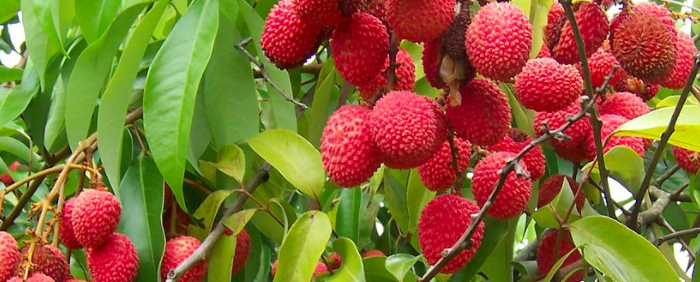
Description of the lychee
The lychee is a fruit from a tree called Litchi chinensis , a species of tropical tree native to southern China 1 . This tree can reach up to 20 meters and produces large quantities of lychees, from 100 to 150 kg per year. It is also grown in India, Thailand, South Africa, Israel, Mexico, Australia and the United States. It is a close relative of longan and rambutan.
It measures between 2 and 5 cm and is surrounded by a thin, rough shell, which becomes rigid after picking. However, it has the advantage of being easy to peel. The fruit stops ripening after picking. At full maturity, the shell is red or pink. If the shell is tarnished or browned, the fruit is too old. The flesh is white, translucent, juicy, fragrant and very sweet. The lychee also has a smooth, brown, inedible central core.
We often compare the taste of lychee to a mixture of strawberry, rose and muscat.
It has very little tolerance for cold, transport and time to market.
History of lychee
This fruit has been cultivated for more than 2000 years in China where tradition considers it a lucky charm. It is sometimes called the “Chinese cherry”.
Nutritional value of lychee
| Per 100 g (about 10 lychees) | |
| Calories | 66 kcal |
| Water | 82g |
| Carbohydrates | 16.5g |
| Protein | 0.8g |
| Fat | 0.4 g |
| Dietary fiber | 1.3 g |
| Vitamin C | 71.5g |
| Potassium | 171 mg |
| Copper | 0.15 g |
| Magnesium | 10 mg |
The health effects of lychee
Vitamin C
Lychee is a good source of vitamin C. The daily requirements for an adult vary between 75 and 90 mg per day. The consumption of 100 g of lychee makes it possible to reach between 80 to 95% of its needs. In addition to its role as an antioxidant and a decrease in oxidative stress, vitamin C contributes to the maintenance of skin integrity, helps wound healing, protects cells from premature aging caused by free radicals and facilitates immune functions 2 . In addition, it facilitates the absorption of non-heme iron of plant origin.
Potassium
Lychee is also a source of potassium. Like sodium, potassium is an essential mineral that performs several necessary functions in the human body. With the help of sodium, it helps maintain the acid-base balance of the body and controls the pH inside cells. It is also essential for the transmission of nerve impulses, for muscle contraction. It also participates in the proper functioning of the kidneys and adrenal glands, as well as in protein synthesis and carbohydrate metabolism. In addition, adequate potassium intakes are associated with a reduced risk of cardiovascular disease 3 .
The use of lychee
Lychees are sold fresh or canned. They can also be found dried or candied. We will rather choose fresh lychees with a colored and not wrinkled skin. They keep in the refrigerator in a perforated plastic bag for a few weeks, or in the freezer in their shell. If they are stored at room temperature, they must be consumed within 48 hours otherwise they tend to ferment and become acidic.
To consume it, remove the shell with your fingers or a knife, taking care not to cut the flesh.
Uses of lychee:
- Raw, as is as a snack or at the end of a meal as a dessert;
- Fruit salads;
- Jams;
- Smoothies;
- Cocktails;
- Sorbets;
- Sauces;
- Pranks;
- Accompaniment of vegetables, rice, fish and seafood.
A word from the nutritionist
With its very high water content, the lychee is a very refreshing fruit. Like most fruits, it is very low in calories and fat, making it a food of choice as part of a healthy diet.